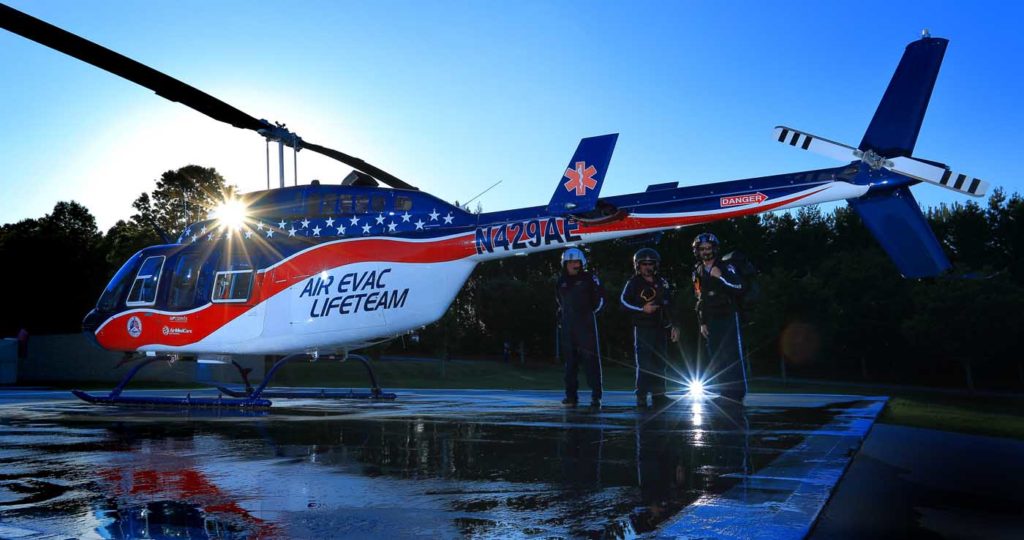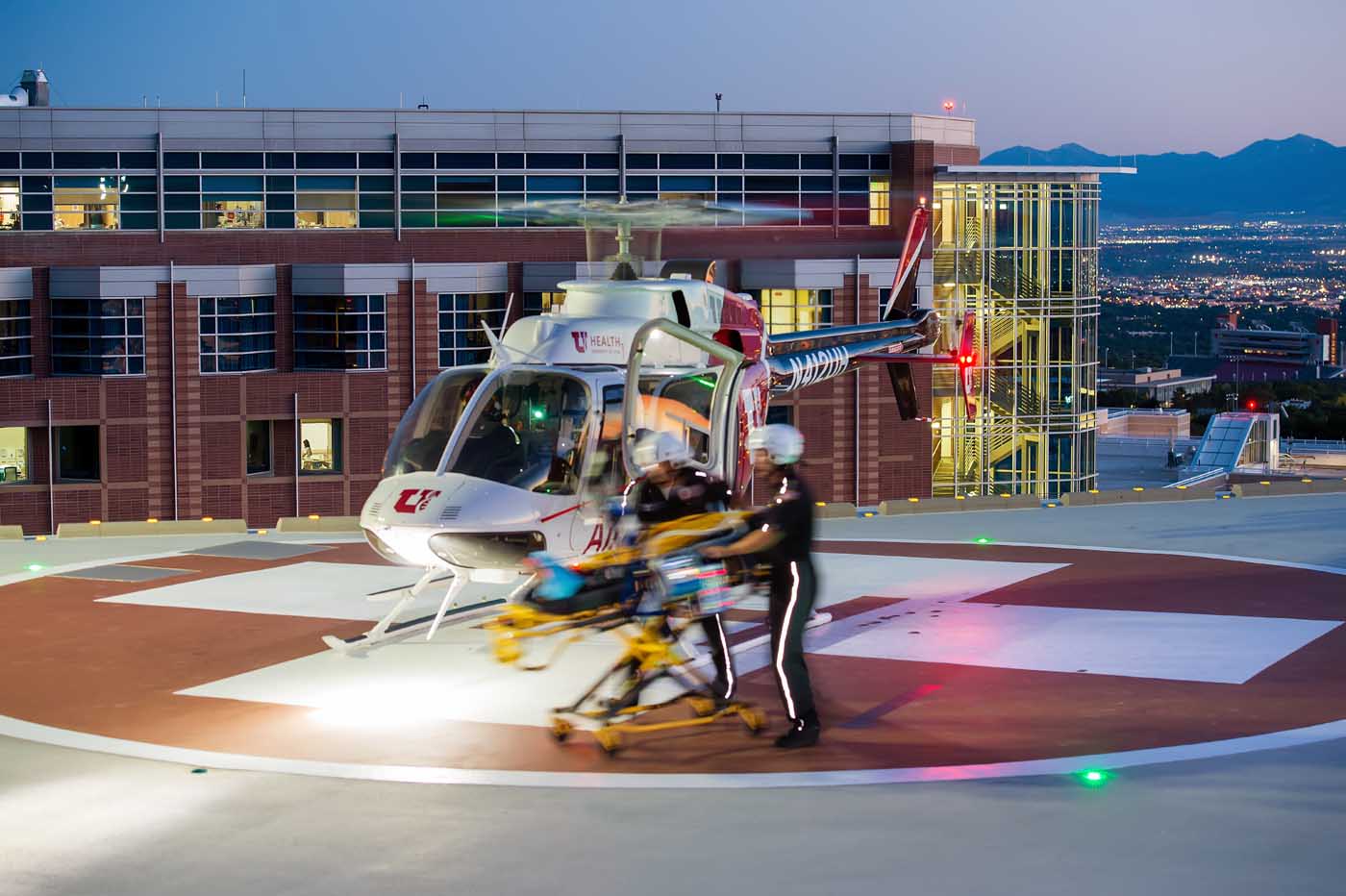The ever-shifting response to an ongoing coronavirus pandemic continues to reshape HEMS in America and will reverberate through the sector for years to come.
As Covid-19 reshaped virtually every aspect of life around the world, helicopter EMS operations pivoted quickly to ensure high-level care while also safeguarding the safety of pilots, medical personnel, mechanics, and support staff. Now, more than seven months into the pandemic, HEMS continues to evolve and change with the shifting medical landscape, so much so that these changes may last long after the pandemic has burned out.
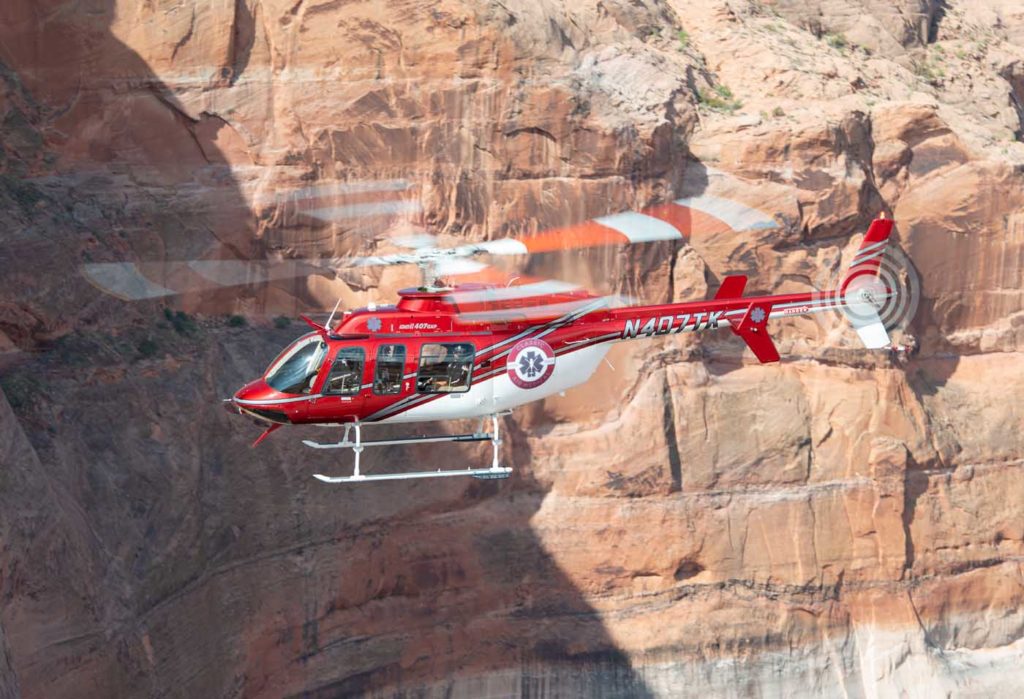
Dr. Ed Racht, chief medical director at Global Medical Response (GMR), sees the continually evolving Covid situation leaving its permanent mark on HEMS, especially when paired with the recent trend of closing rural hospitals. GMR operates helicopters, airplanes, and ground ambulances throughout the United States, transporting close to 4.9 million patients a year.
“My sense is helicopter EMS isn’t going to go back to where it was before Covid,” said GMR’s Racht. “The need to serve rural communities is acute and there is a lot of talk about helicopters. You can’t drive a stroke victim several hours in an ambulance. Helicopter EMS really has the potential to provide support to every rural and frontier area. When a hospital closes, you need to get patients from that former hospital’s area to care in timely manner. Covid has really emphasized that and spotlighted the value helicopters bring to EMS.”
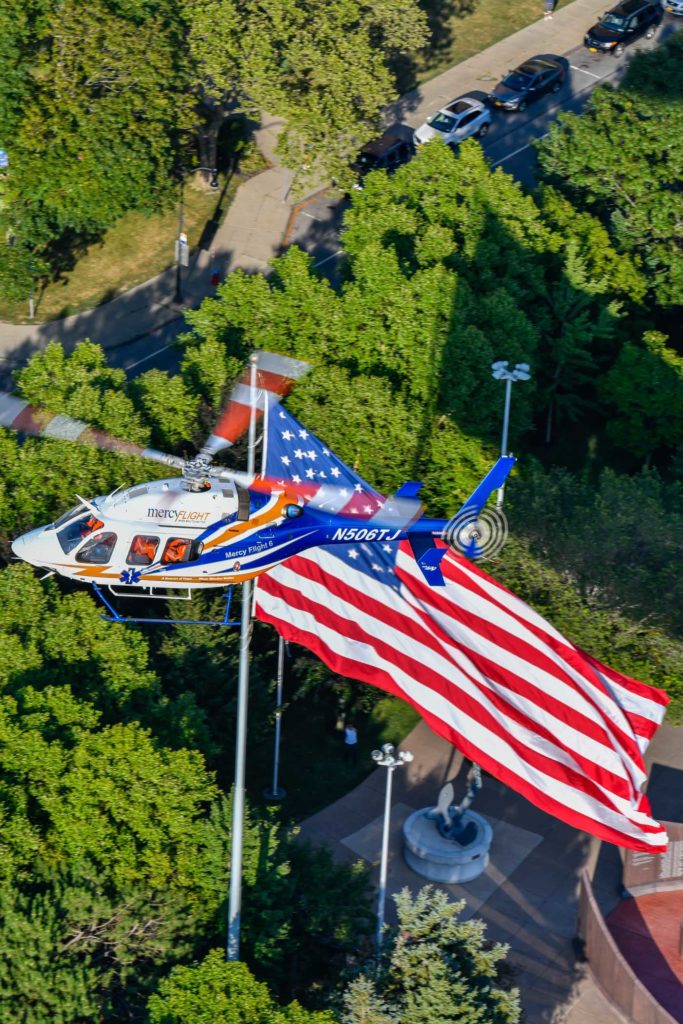
In addition to transports to care centers further from home, Racht sees rural communities potentially having transports in the other direction, where care providers fly to the patient. As the medical community learns more about the long-term effects of coronavirus infection, patients could begin needing urgent transport because of post-Covid complications.
“We don’t know what this post-Covid patient population will look like in the long term either,” he added. “Until we fully understand all the complications and how long they’ll stay around, we can only speculate on the level of care needed and how helicopters will play into that.”
Taken together, these key issues, paired with lessons learned globally on how to safely transport highly infectious, acute cardiopulmonary patients, are changing and likely will continue to alter helicopter EMS operations.
“Anyone who says this is what HEMS is going to be like from now on is describing the end of the book when they’ve only read the first few chapters,” Racht said. “This is still in the beginning. This is a journey. How we continue to evolve, keep up, change, and put what we learn into practice will get us to the ending.”
The first few chapters
When the coronavirus first arrived in the U.S., HEMS operators began stocking up on personal protective equipment (PPE) and adopting new protocols to safely transport positive and potentially positive Covid patients. As the medical industry learned more about the disease, its symptoms, how it spread, and complications, air ambulance companies updated their procedures and evolved with the pandemic to best serve their communities.
Except for Covid hot spots, the HEMS sector initially experienced a dip in transports and a significant decline in scene calls of between 50 and 70 percent in some places. Part of that decrease was due to stay-at-home orders. Fewer people getting out meant fewer accidents.
A temporary halt on elective surgeries also played a factor. Simultaneously, hospitals reported a noticeable drop in the steady flow of heart attacks, strokes, and non-Covid-related breathing issues typically seen across the nation. Medical experts believe this was the result of a combination of less activity and fear of going to the hospital where there was a chance of catching coronavirus.
The deepest valley of the lull didn’t last long — a few weeks to a month in most regions of the U.S. Transports and scene calls on a whole returned to at or close to pre-Covid levels within a few months with one significant change — the types of transports.
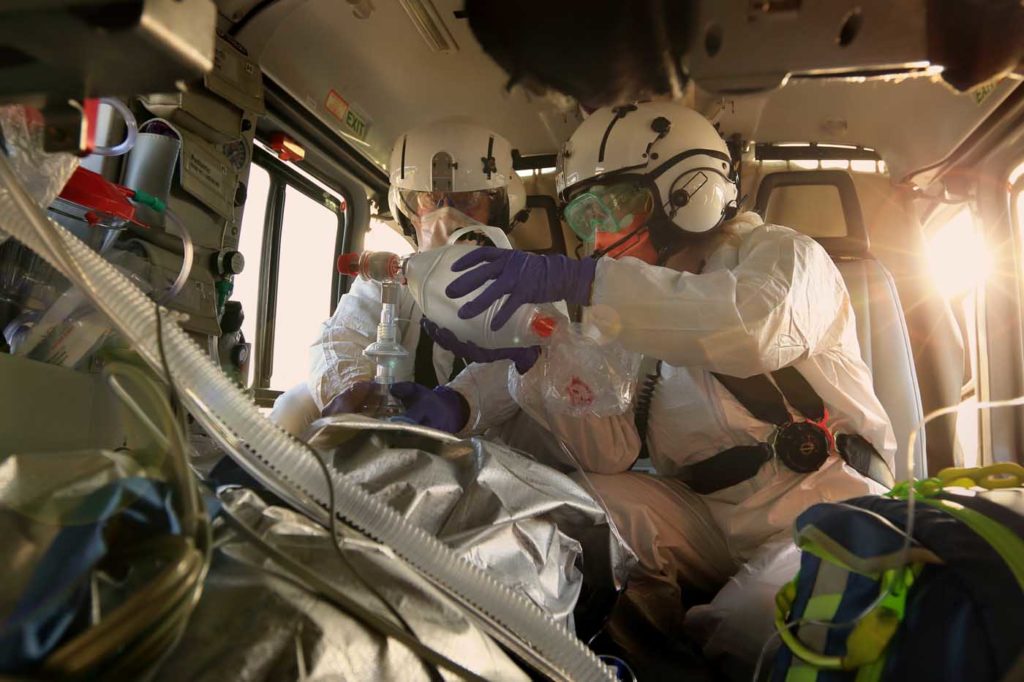
Rural response
Classic Air Medical, an operator serving rural areas across the intermountain region — Utah, Wyoming, Colorado, Idaho, Arizona, and New Mexico — had to pivot rapidly to support rural communities. Patient isolation pods did not initially fit into the company’s Bell 407 helicopters. They quickly redistributed assets to ensure their aircraft were moved to areas with the highest need.
Classic Air Medical serves the Navajo Nation, where the rural isolation of the tribe, paired with tight family groups, allowed Covid to ravage the community early on in the pandemic. Classic moved aircraft to Page, the closest base to the reservation, and began performing all Covid transports with fixed-wing aircraft to transport critical patients to larger hospitals in Phoenix.
“The Navajo Nation is so remote and Indian Health Services [intensive care units] are very small,” says April Larsen, executive director of clinical operations at Classic Air Medical. “Patients were getting sick so fast. They’d walk into the hospital and within 24 hours be critical. We were able to support them with the airplanes, getting them to Phoenix faster than we could have with helicopters, and with more medical support through the iso-pods.”
In addition to increased Covid transports, the HEMS industry began to see an influx of patients that under normal circumstances may never have needed helicopter transport.
“People delaying medical care was a huge issue,” said Dr. Scott Van Poppel, medical director for PHI Air Medical, who supports PHI’s HEMS operations in North Texas. “People who would normally come for chest pain or stroke-like issues were scared to go to the ER. By the time they called 911, it had progressed. That was one of the most difficult things to see. That heart attack or those early stroke symptoms that could have been treated right away turned into something worse by the time they come to medical care.”
Van Poppel said transports of people who had delayed care leveled off by late summer, likely a result of increased telemedicine and increased comfort in seeking medical support.

Ills of isolation
The virus also caused an increase in transports as a result of social isolation and the psychological stress of shutdowns. Flying transport-only flights with LifeLine Johns Hopkins All Children’s Hospital in St. Petersburg, Florida, flight nurse Michele Armstrong sees the effect Covid is having on children and the people who care for them.
Children aren’t experiencing the symptoms of the disease in as large of numbers as adults. Since Covid came to Florida and people began staying at home from work and school, she witnessed very few child Covid patients. What did increase are instances of trauma.
“Child submersions and unintended trauma began increasing after schools closed as parents were forced to work from home with no childcare,” Armstrong said. “People are stressed and struggling to balance home and work. Parents and guardians became more distracted. In some cases, they have grandparents watching the kids, and grandparents present new hazards, such as medications laying around and a lack of awareness of how best to keep the kids safe. This all results in a reduction of child supervision and that’s where kids get hurt, or worse.”
Social isolation brought on by Covid has been linked to an increase of attempted suicides. Drug abuse is up in middle- and high-schoolers as they seek escapism while non-accidental trauma (child abuse) in younger children is also on the rise, Armstrong said. She is also seeing increased incidents of neonatal abstinence syndrome as more pregnant mothers turn to drugs.
“Everyone’s life changed overnight, and they struggled to overcome,” she said. “That can be drugs and alcohol, violent outbursts, or attention-seeking behavior like attempted suicide. Overall, I really can’t say our transport numbers are higher since Covid. They are more acute and so just feel more pronounced.”
As summer progressed, HEMS operators reported another interesting trend in coronavirus patients. They were transporting more young people with the disease than in the spring, and those patients were generally much sicker than the early Covid patients.
“When we first started seeing Covid in March, we thought only the elderly and immunocompromised were at risk,” said Van Poppel. “Now we see that’s not the case. I personally think this increase is due to the younger generation feeling they can beat this, so they stay home and take over-the-counter medications for several days before becoming so critical they call 911.”
After the first few months of the pandemic, operators began transporting patients with severe post-infection complications.
“Covid causes hypercoagulability, a thickening of the blood, which is causing strokes, heart attacks, blood clots, and breathing issues,” said Van Poppel. “By summer, we were transporting people who initially recovered from Covid, but were now sicker because of complications. It has really been a different type of disease. It’s made us adapt to how we use ventilators and drugs and we’ve had to readjust on the fly.”
Fall 2020
Now in October, the medical industry is experiencing a double second wave. The Covid Tracking Project reported hospitalizations the last week of September were the highest since July. Not only are Covid cases increasing in some parts of the country, and expanding in some rural areas, but life-threatening complications in patients who have recovered from the disease continue.
“The mortality rate in patients with Covid is dropping, which shows we’re better understanding how to manage care of Covid patients,” said GMR’s Racht. “Now the focus is post-Covid. It’s hard to tell if more of our transports are post-Covid related. They could very well be, but we’re still learning what the longer-term effects of Covid are, as well as recurrent effects.”
In the intermountain region, there is some good news. Iso-pod transports are down for Classic Air Medical, as are Covid transports on a whole.
“We don’t think this is going away anytime soon, but we’re taking advantage of this dip to prepare if things get worse,” said Classic Air Medical communications center director John Park. “We’re tracking increased cases across our region. So far it hasn’t led to more cases, but we’re ready if they do.”
Classic recently developed a helmet-type device that acts much like a continuous positive airway pressure (CPAP) machine to use to transport Covid patients in the helicopter. With this device, the company can now transport more Covid patients, especially in the more rural and rugged areas where Classic operates.
Caleb Curtis, regional educator for Air Evac Lifeteam in Georgia, also is seeing transports and scene calls leveling out. While his team transported Covid patients early in the pandemic due to the spike in the state of Georgia, he sees those patient numbers reducing as the medical industry gets better at managing patient care. Scene calls have picked back up since early summer when the state opened.
As fall progresses, HEMS operators have prepared for the worst. Van Poppel is keeping his eyes on two things in particular: the potential of an influenza outbreak that could add to the Covid pandemic, and the current Covid spike in Europe. While this isn’t expected to have an effect on HEMS capacity, Van Poppel worries about hospital capacity.
“Europe was ahead of us the first time and it is very concerning to see spikes taking place again there,” he said. “We’re watching it very closely as we stock up for the flu season, and a little more for Covid.”
A heart for HEMS
The good news is after more than six months of coping with this constantly shifting situation, HEMS operators and teams have become very good at operating in the new environment. Staffing and overall operations are approaching national rates similar to this time last year, with additional HEMS capacity available if needed. Other than deeper and more consistent decontaminations between flights, basic operational demands on the aircraft haven’t much changed.
“Our medical teams have gotten very comfortable with their PPEs,” Van Poppel said. “In June, it was very uncomfortable — putting on equipment, not touching your face, keeping equipment covered, ensuring your PPE is in the right spot before getting into things. It was about developing habits. Now it is habit.”
While helicopter medical teams have developed habits, pressures and stress on the teams have also improved, Racht said. However, like everyone in the country, HEMS teams have also developed significant fatigue — from the disease, from constant change, from physical exhaustion.
“While we all go through this fatigue and worry from Covid, I’ve seen our more than 35,000 staff rise to the challenge,” Racht said. “Whatever that gene is that got us into this line of work is what is keeping us all going.”
